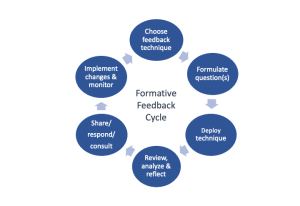Student Feedback
As in most post-secondary institutions, UBC uses student evaluations, called Student Experience of Instruction, for end-of-course student feedback. These evaluations provide valuable insights into students’ learning experiences, but they are also ‘summative,’ meaning that they are collected when a course is almost over, thus, and any changes implemented in response will not have immediate impact. Therefore, it is recommended that formative feedback be incorporated as a regular practice throughout the term.
At the same time, research has shown that student evaluations are subject to gender and ethnicity bias (Fan et al., 2019; Peterson, Biederman, Andersen, Ditonto, & Roe, 2019). Thus, you should consider what additional types of feedback (such as formative techniques) and sources of feedback (such as teaching observations) can help you reflect and improve your teaching.
There are many ways in which to collect formative feedback, i.e. input from students about ways in which instructional strategies, activities, and assessments are helping them learn and could be falling short. These can range from informal conversations to anonymous surveys, and a variety of techniques in between that can simultaneously help students self-assess their own learning.
A useful practice is engaging in mid-course formative feedback. Research has shown that implementing changes in response to the feedback can have a positive impact on end-of-term feedback as well as enhancing the value students place on course evaluations (Taylor, Knorr, Ogrodnik & Sinclair, 2020).

It can be helpful to think about formative feedback as a series of cycles rotating through your course to give you input when and where you find it useful. The following steps can guide you through the process:
- First consider your purpose for eliciting feedback (Ex. to check for misunderstandings; determine if an assigned reading was useful) and then choose a feedback technique that aligns (Ex. Muddiest point for misunderstandings; Reading Rating Sheets for assessing assigned readings).
- Next formulate your question(s) so that they are succinct, clear, and address your purpose. Or ask your students to co-create the questions.
- Deploy your technique whether it be distributing a survey, adding questions to the end of an assignment, displaying a question on your last lecture slide, or conducting an online poll.
- Review and analyze the results as soon as possible and reflect on what they mean not only for the majority of the class, but also for the outliers.
- If possible, be ready to share a summary of the results the next time your class meets. Be sure to anonymize responses as needed to focus on the content of the feedback and not the source. Sometimes summarizing in a sentence or two is sufficient, for example, when highlighting that the most common Muddiest Point was X. In such a case, it is easy to respond by taking some time to further clarify or provide additional resources. In other cases, it may be necessary to consult with students to help you interpret the results and decide on next steps. For example, if an assigned reading was rated ineffective, you would need to find out whether it was due to its level of difficulty, length, or some other reason.
- The most important step is to implement changes and monitor those to see if they address the identified issues. In the case of an “ineffective reading,” you might decide after consultation with students that having you model annotating a reading and then asking them to apply the same techniques would be beneficial. In addition, you might make the annotation a collaborative activity so that as students collectively annotate, they can self-asses their understanding and you can monitor their learning and skill development.
Perhaps you are skeptical of asking students for feedback because based on prior experience, you have found their comments to be too vague or general and sometimes emotionally charged. The quality of feedback can be greatly improved by 1) communicating how much you value student feedback, in particular by sharing and responding to feedback results, and 2) providing guidance so that students become more skilled at identifying and producing effective feedback. Some general tips for giving useful feedback include:
- Be kind: Focus feedback on behaviour, activity, assignment, etc. and not the person
- Be balanced: Commend what worked for you as well as what didn’t
- Be realistic: Focus on what is in the instructor’s domain to change
- Be specific: Give examples, details whenever possible
- Be creative: Offer alternative ideas, suggestions for improvements
See also this example of a feedback guide for students from the University of Texas at Austin.